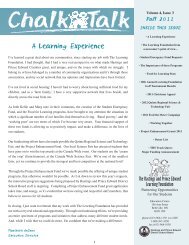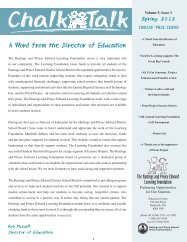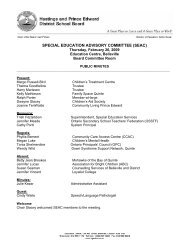Grade 11 Healthy Active Living Education Additional Supports ...
Grade 11 Healthy Active Living Education Additional Supports ...
Grade 11 Healthy Active Living Education Additional Supports ...
Create successful ePaper yourself
Turn your PDF publications into a flip-book with our unique Google optimized e-Paper software.
Positive Mental Health and Stress<br />
Public Profile<br />
Unit #3 Activity #3<br />
Teaching Learning Strategy #6<br />
Teacher Resource (Background Information)<br />
Stress Management Techniques/Strategies Definitions<br />
Catholic Profile<br />
Unit #5 Activity #3<br />
Teaching Learning Strategy N/A<br />
Relaxation Response<br />
Opposite of the stress response: Heart rate, respiration and blood pressure drop, muscular<br />
tension disappears, sweating stops, etc.<br />
Relaxation Technique<br />
This is a method that can be learned and used to control the level of arousal due to stress.<br />
The first step is learning to be aware of the level of tension. The next step is learning<br />
mental and physical techniques to promote the relaxation response and achieve a state of<br />
inner calm. In this state, one can focus on the problem causing the stress and increase<br />
oneÕs capacity to deal with it. OneÕs mind is open to positive suggestions.<br />
Mind-Body Connection<br />
A term used frequently to describe the interconnectedness of the psychological and<br />
physical parts of the human organism. It is the basis for the efficacy of relaxation<br />
techniques.<br />
Biofeedback<br />
Initially sophisticated machines that measure pulse or galvanic skin response (degree of<br />
sweating) and emit a sound that becomes more or less intense as the level rises and falls<br />
monitor a personÕs level of arousal. The feedback allows the person to monitor and<br />
change the level of arousal. Eventually the person is able to achieve relaxation without<br />
the machine. The method has proven effective for people who get migraine headaches.<br />
Breathing Techniques<br />
Taking a deep breath is a natural way of reducing stress. More advanced techniques<br />
teach deep abdominal breathing and focus on the act of breathing. Breathing to a<br />
particular cadence which may include partial and full breaths, or stopping momentarily<br />
between inhalations and exhalations are additional breathing techniques.<br />
Exercise<br />
Physical activity promotes the relaxation response by putting the accumulated stress<br />
hormones (adrenaline) to use. Aggressive feelings can be legitimately expressed.<br />
Focussing on the activity can provide a restful Òtime outÓ from the sources of the stress.<br />
Exercise also promotes better sleep and a healthier immune system.<br />
<strong>Grade</strong> <strong>11</strong> <strong>Healthy</strong> <strong>Active</strong> <strong>Living</strong> <strong>Education</strong> (PPL30), Module #2 Positive Mental Health and Stress<br />
Page 35
















